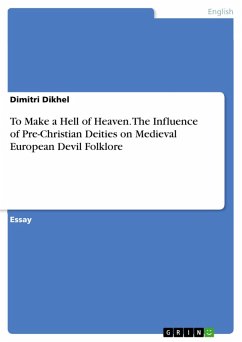Essay from the year 2020 in the subject English Language and Literature Studies - Literature, grade: 1,5, Ruhr-University of Bochum, language: English, abstract: In this essay I am going to argue that the medieval perception of the Devil incorporated iconography previously associated with the deities of pre-Christian Europe as part of their demonization under the interpretatio Christiana. While numerous literary portrayals of Satan from that period draw from "heathen" imagery, they do not always exemplify the larger trend of demonizing pagan gods. Although Satan's tricephalic form in Dante's Divina Commedia is likely to have been at least partially inspired by the Greek goddess Hecate, for instance, there do not seem to have been enough depictions of the Devil as having three faces to use this as an example of how Hecate was demonized. It is the more prevalent, folkloric portrayals of the Devil with hooves, horns, a forked tongue and carrying a pitchfork, bearing little resemblance to his theological counterpart (cf. Russell, Lucifer), that highlight the interpretatio Christiana of the Germanic Æsir and the Greco-Roman pantheon. As Richard Kiekhefer states in Magic in the Middle Ages (1989), "orthodox opinion" in early medieval Europe "held that pagan religion was no true religion but mere demon-worship". Thus, while figures such as Loki were imbued with Satanic qualities in later retellings of Norse myths, reinterpreting his shapeshifting and gender-fluidness as a sign of evil, iconography associated with Norse and Greco-Roman gods, such as goat legs, dogs, snakes and tridents, was incorporated into medieval Christian Devil folklore.
Dieser Download kann aus rechtlichen Gründen nur mit Rechnungsadresse in A, B, BG, CY, CZ, D, DK, EW, E, FIN, F, GR, HR, H, IRL, I, LT, L, LR, M, NL, PL, P, R, S, SLO, SK ausgeliefert werden.









